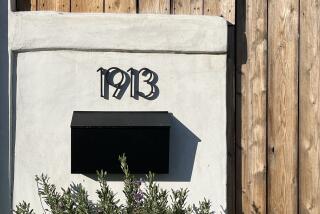The shed goes chic
WHEN her teenage nephew moved in, Shirley Miller shuttled her home office from a spare bedroom to the dining room of her Sherman Oaks house.
It wasn’t ideal, not with her own teenage son still living at home. But adding onto the 1,500-square-foot house would have cost $110,000 to $130,000, so she did what a growing number of squeezed homeowners are doing: She bought a kit for a pint-sized cottage and erected it in the backyard.
Now she strolls across the grass and opens the French doors into her 12-foot-by-16-foot office, where she writes training programs for businesses. The gray exterior, trimmed in white, blends with her home. Inside, white furniture offsets the sky blue walls.
Miller and others are redefining the common backyard shed. Once shabby, now showy, the shed has become a haven for the home office, art studio, sewing niche or guy getaway.
It’s cheaper than adding on, goes up faster and looks nothing like a place to stash the lawn mower. The sheds come in a variety of styles -- rustic, urban modern, dollhouse -- and some owners add comfy features such as air conditioning, sky lights, custom windows and doors, everything but plumbing.
Miller is happy with her backyard retreat, though the $12,000 kit she bought from Summerwood Products last fall ballooned into a $25,000 project by the time she was done.
And she hit some bumps along the way -- pitfalls that others might heed.
Her kit arrived in a big box with sections pre-assembled by Summerwood, a Toronto company that uses Canadian cedar. She hired a contractor to lay a concrete foundation and put it all together for $10,000.
“It was reasonably easy to build,” Miller said.
All was well, until a Los Angeles building inspector knocked on her door one day. “I had it built without permits,” said Miller, still in the dark about who reported her. Though it was built to code, accessory buildings larger than 64 square feet need a building permit in the city.
“I had to retroactively get permits,” she said. “It was not a fun experience.”
The additional engineering drawings and permit process added $3,700 and four months to the project. The permit process caused her to go over budget and she had to finish off the interior herself.
“After all the gnashing of teeth, now I’m happy,” she said. “It’s nice looking. It doesn’t look cheesy.”
Homeowners don’t have to spend as much as Miller did, though they may sacrifice on the quality of the wood, the look and other amenities such as glass doors.
Costco sells kits in the $2,000 to $3,000 range. Home Depot sells Tuff Shed structures for about that, including a one-day installation.
A $3,000 barn-style shed from Home Depot, for example, can be turned into a home office for an additional $2,000, if the owner does the insulating, drywalling, tiling and painting. Even handier types can buy a set of building plans and do it all themselves or hire a contractor.
Dan Gray built a shed about 10 years ago and has been dispensing tips ever since, morphing his passion into www .geekbooks.com eight years ago. Based in New Jersey, where he writes computer how-to books, Gray has seen a rising interest in the backyard retreat.
“It’s folks running out of space,” he said. “They need a place to work that’s quiet, away from the house.” California’s mild climate makes the shed a good solution.
First, check with the city
He recommends a trip to the city’s building department first to see what permits are required. Many places in the state allow backyard structures of up to 120 square feet without a building permit, but some cities are more restrictive and have differing setbacks and height limits. Also, a permit for electrical wiring is probably necessary.
Gray’s other suggestions:
* Go with real wood, not plastic, steel or chipboard. “Cedar is an excellent choice.”
* Build it big enough. “You’ll never want a smaller shed. . . . Go as high as you can; the extra space overhead is valuable for storage.”
* If you leave the interior unfinished, you’ll gain some shelving space.
* Make sure there is proper ventilation and that the windows can open and shut. Some prefab sheds and kits are insulated and finished on the inside; others aren’t.
* Siting is important. “You want to take advantage of the natural light without roasting.” And take drainage into consideration. It will be easier to keep dry and stave off rot if the structure isn’t located where water collects after a rain.
As for foundations, many companies say they aren’t needed. The buildings can rest on level gravel, patio stones, cinder blocks or concrete footings. Tuff Shed uses a steel floor joist system that the shed sits on.
Foundations help distribute the weight of the shed evenly to prevent warping and windows and doors that don’t work. “But they can cost the owner a chunk of change,” Gray said.
Steven McKee of S.P. McKee Design & Construction in Newbury Park pegs the cost of a slab for a 120-square-foot shed from $800 to $3,000, depending on the slope of the land, geographic area and contractor.
Building from scratch instead of using a panelized or pre-cut kit will save up to 30%, Gray said. But a kit is easier and faster, and owners know exactly how the final product will look.
Alisa Ratner likes the contemporary style of her new art studio in the backyard of her Pacific Palisades house. She and her husband, Kevin, bought the 10-by-12-foot shed from Seattle-based Modern Shed for about $10,000. It was delivered in pre-built panels. The couple then contracted for the two-man assembly, which usually takes three to four days. The final tab: about $17,000.
With its maple interior and tiled floor, the airy shed sits on four concrete blocks near the edge of a canyon, affording Ratner an ocean view. It is here that she works on her fine-art printing, undistracted by her 1- and 3-year-old sons being cared for in the house.
“There’s a psychological separation,” she said. “I love being out there.”
David Ballinger, who founded Florida-based MetroShed in 1995, said people want to work at home, but they still want a “30-second commute,” to avoid the ringing doorbell, the screaming children, the barking dog.
He’s been selling sheds in the Los Angeles area the last five years and has found his customers’ No. 1 use is an art studio, followed by a home office.
Two and a half years ago, real estate agent Craig Terrien bought a MetroShed and moved his home office into the backyard of his San Fernando house.
“We were expecting another child,” he said, “so I had to vacate the bedroom.”
He put it together with a little handyman help, but he said he’d hire a contractor to build it all if he had it to do over. He’d still come out ahead, figuring that adding on to his house would have cost about $40,000 compared with the $12,000 he put into the shed.
Terrien, who rented out the house a few months ago, says he believes the shed adds to the value of his property. One couple was so taken with his cozy quarters, he said, that they bought a house from him that was too small for their needs but added a shed to the backyard.
But Realtor Colleen Badagliacco said it’s not that clear whether extra space in a separate structure makes a difference. “Obviously, the quality has something to do with it and how it ties in with the property,” said Badagliacco, president of the California Assn. of Realtors.
“If it’s not code compliant,” she said, “it’s almost a negative.” And if it takes up most of a small backyard, that might turn off buyers. “Whether you get your money out of it is a market-driven thing.”
Dollar for dollar, owners would probably get more of a return by adding on to the house, she said, although that’s a larger investment than a shed.
You call that a shed?
No one would ever look at Linda Phillips’ art studio and mistake it for a shed. Living in the hills above Ojai, she paints watercolors in an elegant yet simple refuge tucked into the rugged hillside below her home.
It’s made of hardwood from Bali and came from a kit created by artist-architect Tony Gwilliam, whose Ojai-based operation sells structures inspired by meditation pavilions and Japanese tea houses. The roof is thatched on the inside and covered with ironwood shingles on the outside.
“It’s my little sanctuary,” said Phillips, who has traveled in Japan and China. “I’m a devout Episcopalian, but it looks like I’m a Buddhist.” Inside, she has a no-shoes policy.
The kit was $8,580, but that was just the beginning for Phillips and her husband. The 10-by-12-foot structure rests on a deck supported by concrete footings. Phillips rinses her brushes in an attached outside sink.
The retired couple started the project in February, and by the time they were done, they’d spent $35,000, a sum that now stuns them.
But Phillips, who never felt she had privacy in the house, is thrilled. Now she pads down the steps to her getaway with its sweeping view of the Ojai Valley and enjoys the solitude. “I don’t hear the phone or my husband.”
--
(BEGIN TEXT OF INFOBOX)
Where to find out more about sheds
For further information on some of the structures on the market, check out these websites:
* Summerwood Products, www.summerwood.com
* European Log Cabins, www.europeanlogcabin.com
* Modern Shed, www.modern-shed.com
* MetroShed, www.metroshed.com
* Dan Gray, www.geekbooks.com
* Tuff Shed,
www.tuffshed.com
* Tony Gwilliam’s T House, www.tonysthouse.com
- JANE HULSE






